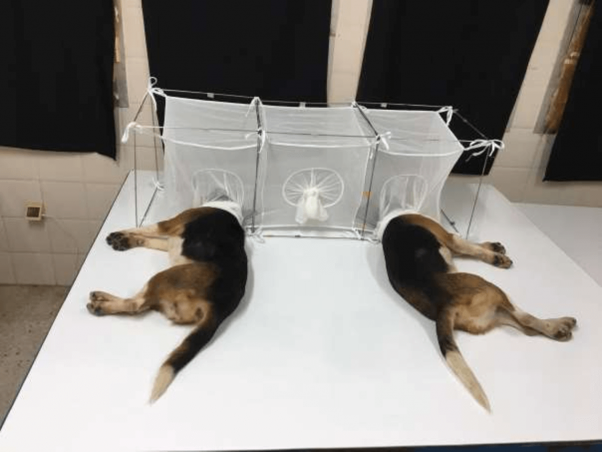PETA’s Been Exposing NIH Atrocities Since 1981—and a Contracted Beagle-Breeding Factory Is the Latest One
In 1981, in international breaking news, PETA became the first to expose an atrocity funded by the National Institutes of Health (NIH). (See the “Silver Spring monkeys” case below.) Now, 40 years on, Anthony Fauci and the National Institute of Allergy and Infectious Diseases (NIAID, his division of NIH) have come under fire for reportedly funding tests in Tunisia in which experimenters drugged beagle puppies and locked their heads inside cages filled with hungry, infected sandflies. The abhorrent details of the experiments have folks up in arms (and rightly so). But while the experiments were certainly appalling, they weren’t surprising—and that’s because of PETA’s lengthy history of exposing and stopping other NIH ugliness, a history that proves that at the agency, the rot has run deep for decades.

5 NIH Horrors PETA Has Exposed Since 1981
Dubbed the Silver Spring monkeys case and known as “the case that launched PETA,” our first undercover investigation (which was also the first-ever U.S. animal laboratory undercover investigation) took place inside the Institute of Behavioral Research, a laboratory in Maryland that had been given hundreds of thousands of tax dollars by NIH to test on monkeys. PETA exposed how experimenters severed the nerves in monkeys’ spinal cords, rendering one of their limbs useless; electroshocked and pinched them with pliers; and kept them inside filthy cages with wire flooring where food fell through to the feces beneath. The investigation resulted in the first-ever search and seizure warrant for a laboratory, the first-ever conviction of an animal experimenter on animal abuse charges, the first-ever revocation of federal research funds because of cruelty to animals, and the first-ever case concerning animals in laboratories to be considered by the U.S. Supreme Court.
For 15 years, University of Pennsylvania experimenters cemented baboons’ heads into metal devices and pummeled their heads with a hydraulic device to cause traumatic brain injuries. But in 1985, the NIH-funded laboratory met its match: After PETA released the experimenters’ own videos, we organized a sit-in protest at the agency’s Bethesda, Maryland, headquarters—90 PETA supporters and animal rights activists took over five NIH offices, refusing to leave until agency execs agreed to watch the footage of the heinous experiments and act in the monkeys’ interests. Shortly afterward, the U.S. government cut off all funding for the experiments.
In 1987, Jane Goodall—the world’s foremost primate specialist—called for the closure of SEMA, a contract laboratory, after PETA released undercover video footage revealing abysmal conditions inside the facility. And after the investigation was featured on international television, SEMA ended the total-isolation confinement of baby chimpanzees, four of whom were rescued from its laboratory. In 2012, under pressure from PETA, SEMA—by then known as BIOQUAL, a company that receives millions of dollars in contracts from NIH and NIAID—ended all use of chimpanzees.
We’ve also taken direct aim at NIH and its massive in-house laboratories. In 2014, armed with video footage obtained by PETA that quickly went viral, we exposed highly controversial, much-criticized abuse of baby monkeys taking place inside an NIH laboratory in Poolesville, Maryland—experimenters were making baby monkeys mentally ill by tearing them away from their protective mothers. Following a PETA-induced crisis for NIH, the agency ended the experiments and closed its Poolesville laboratory.
More Work Ahead
With your help, we’ve put a stop to the torture above as well as countless other outrageous tests conducted or funded by NIH. But the agency and its “dinosaurs” are still relying on failing animal models, which means that we’ve still got work to do. Last year, for example, we published never-before-seen video footage of NIH experimenters terrifying brain-damaged monkeys with realistic-looking fake snakes and spiders as part of a decades-long project in which monkeys are abused and terrorized—experiments that have cost you, the taxpayers, $47 million. Since we launched our campaign, more than 200,000 PETA supporters have sent e-mails and made phone calls, we’ve led numerous spirited protests, and experts have weighed in with support in urging NIH to shut down the laboratory.
If you’re still mad about the tests on beagles in Tunisia, prepare for your blood to boil after watching the video footage from PETA’s latest undercover investigation: On the heels of the viral Fauci-NIAID revelation, we’ve revealed how at Envigo, a Virginia supplier of beagles to NIH and other laboratories for use in experiments, nearly 5,000 beagle dogs and puppies were intensively confined to small, barren kennels and cages 24/7. During our investigator’s time at Envigo, more than 360 dead puppies were found—some had been crushed by their mothers inside the cramped cages that they were forced to live in, others died of pneumonia or hepatitis, and some had been left to rot alongside their surviving siblings. Our investigator rescued one dog (now named Samson) from the factory’s horrific conditions, but so many others still need our help. Will you join us in taking action?
Frightening monkeys with fake snakes and torturing beagles and are just two examples of NIH’s ethical, fiscal, and scientific failures. With the resignation announcement of NIH Director Francis “Blind Eye” Collins, we have a rare opportunity to influence the course of scientific research in the U.S. and help end decades of cruel and wasteful animal experimentation. It is crucial that we seize it. So we’ve been busy urging President Joe Biden not to hire another “dinosaur” to direct NIH. We need leaders unafraid to chart new courses. Please take a moment to urge him politely to choose well:

